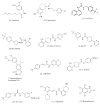TRPV1: on the road to pain relief
- PMID: 20021438
- PMCID: PMC2802457
- DOI: 10.2174/1874467210801030255
TRPV1: on the road to pain relief
Abstract
Historically, drug research targeted to pain treatment has focused on trying to prevent the propagation of action potentials in the periphery from reaching the brain rather than pinpointing the molecular basis underlying the initial detection of the nociceptive stimulus: the receptor itself. This has now changed, given that many receptors of nociceptive stimuli have been identified and/or cloned. Transient Receptor Potential (TRP) channels have been implicated in several physiological processes such as mechanical, chemical and thermal stimuli detection. Ten years after the cloning of TRPV1, compelling data has been gathered on the role of this channel in inflammatory and neuropathic states. TRPV1 activation in nociceptive neurons, where it is normally expressed, triggers the release of neuropeptides and transmitters resulting in the generation of action potentials that will be sent to higher CNS areas where they will often be perceived as pain. Its activation also will evoke the peripheral release of pro-inflammatory compounds that may sensitize other neurons to physical, thermal or chemical stimuli. For these reasons as well as because its continuous activation causes analgesia, TRPV1 has become a viable drug target for clinical use in the management of pain. This review will provide a general picture of the physiological and pathophysiological roles of the TRPV1 channel and of its structural, pharmacological and biophysical properties. Finally, it will provide the reader with an overall view of the status of the discovery of potential therapeutic agents for the management of chronic and neuropathic pain.
Figures



References
-
- Montell C, Rubin GM. Molecular characterization of the Drosophila trp locus: a putative integral membrane protein required for phototransduction. Neuron. 1989;2:1313–1323. - PubMed
-
- Caterina MJ, Schumacher MA, Tominaga M, Rosen TA, Levine JD, Julius D. The capsaicin receptor: a heat-activated ion channel in the pain pathway. Nature. 1997;389:816–824. - PubMed
-
- Tominaga M, Caterina MJ, Malmberg AB, Rosen TA, Gilbert H, Skinner K, Raumann BE, Basbaum AI, Julius D. The cloned capsaicin receptor integrates multiple pain-producing stimuli. Neuron. 1998;21:531–543. - PubMed
-
- Caterina MJ, Julius D. The vanilloid receptor: a molecular gateway to the pain pathway. Annu Rev Neurosci. 2001;24:487–517. - PubMed
-
- Ramsey IS, Delling M, Clapham DE. An introduction to TRP channels. Annu Rev Physiol. 2006;68:619–647. - PubMed
Publication types
MeSH terms
Substances
Grants and funding
LinkOut - more resources
Full Text Sources
Other Literature Sources
Medical

